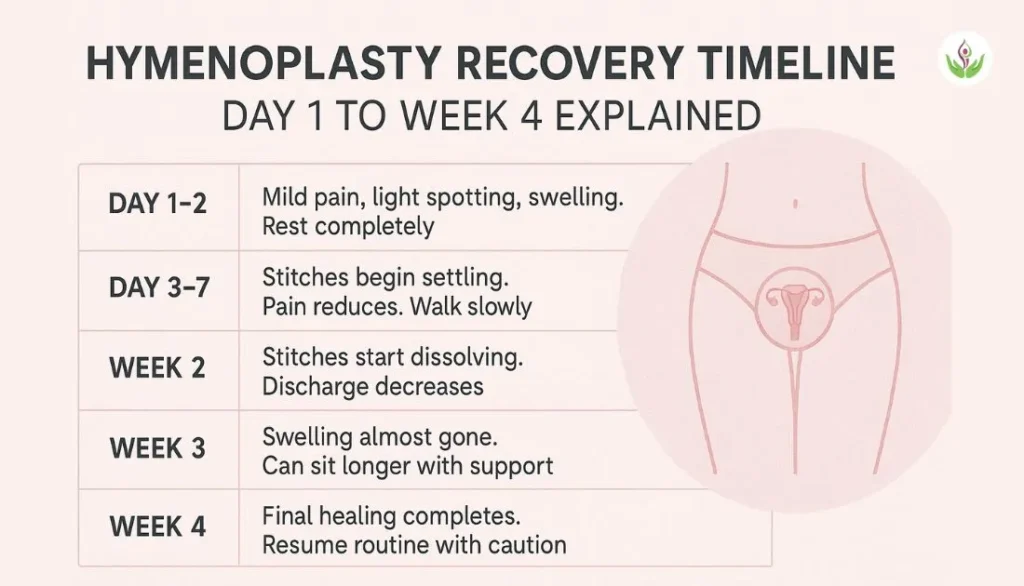Personalized Guidance on Hymenoplasty Recovery from Dr. Sandeep Bhasin
As a surgeon, I have performed hymenoplasty for many years, and I want to speak to you directly. It’s understood that considering hymenoplasty is a deeply personal decision, and it’s natural to have emotions, hopes, and worries. That is completely normal. This hymenoplasty recovery timeline is designed to guide you with clarity, care, and expert insight.
Many women come to me with one common question — what will happen after the surgery? And I always say that the recovery phase is just as crucial as the procedure itself. How you take care of yourself in the days and weeks that follow can strongly affect your final results.
You may feel nervous about pain, bleeding, walking, or even your first period after surgery. Some women worry about the stitches. They wonder if healing will go well or if something may go wrong. These are valid concerns, and every woman deserves clear answers.
This guide takes you through the hymenoplasty recovery journey from day one to week four. Each stage has its changes, sensations, and care needs. Reading the preceding guide informs you about what you can expect during a normal recovery and some potential concerns. This guide aims to provide clear, honest information to prepare you for the process. With the right care and mindset, recovery becomes smoother, more comfortable, and more reassuring. You can also check details of virginity restoration surgery in Delhi for more clarity on the procedure.
What Is the Hymenoplasty Recovery Timeline?
Hymenoplasty recovery happens in small stages. Each week brings new changes — from initial rest to full healing. Each phase of recovery brings different changes. When you know what to expect, you feel more calm and prepared. The timeline below shows how healing usually happens, step by step.

Hymenoplasty Healing Timeline: Day 1 to Week 4
| Time Frame | What to Expect |
| Day 1–2 | Mild pain, light spotting, swelling. Rest completely. Avoid movement and stay indoors. |
| Day 3–7 | Stitches begin settling. Pain reduces. Walk indoors slowly. Clean gently once daily. |
| Week 2 | Stitches start dissolving. Discharge decreases. Light activities allowed. No bending or lifting. |
| Week 3 | Swelling almost gone. Can sit longer with support. Begin light home chores. Avoid sexual activity. |
| Week 4 | Final healing completes. Daily comfort improves. Resume routine with caution. Still avoid pressure or friction. |
Day One to Day Two: What to Expect Right After Hymenoplasty
Many women have questions like what to expect after hymenoplasty or what about the first three days after hymenoplasty. Let me clear that for you! During the first two days after hymenoplasty, your body starts healing, so focus on rest, pain relief, and hygiene. Slight discomfort, light spotting, or swelling are some common concerns. You don’t need to worry about these, as they are normal and easy to manage. So, stay calm, follow the care instructions, and avoid unnecessary movement to support healing.
Pain and Discomfort
Don’t worry about mild and moderate pain, as it is common. It usually feels like pressure or soreness around the stitched area.
To stay comfortable:
- Take your pain medicine as advised.
- Avoid sitting for long periods.
- Rest with your legs slightly raised.
Most women feel soreness or pressure in the stitched area during the first few days. If you are concerned about how much it might hurt, read more about whether hymenoplasty surgery is painful.
Bleeding and Discharge
Slight spotting or watery discharge may occur within the first forty eight hours.
This is normal unless:
- Bleeding becomes heavy.
- Discharge turns yellow or foul-smelling.
Movement and Activity
Limit your movement as much as possible. Stay indoors and rest.
You may:
- You may walk short distances indoors, as gentle movement supports blood flow. Many women ask, Can I walk after hymenoplasty?” The answer is yes, but only in moderation.
- Avoid climbing stairs or lifting any weight.
Hygiene and Wound Care
Proper hygiene prevents infection.
Follow only the care instructions shared during your discharge:
- Clean the area with the prescribed antiseptic.
- Do not apply home remedies or talcum powders.
- Wear clean, loose cotton undergarments.
Post-Procedure Care: Guidelines for a Smooth Recovery
To prevent infection and any other concerns, you need to follow hymenoplasty aftercare instructions. If you’re in doubt about how to clean after hymenoplasty surgery, you can use lukewarm water to maintain hygiene and wear soft cotton underwear. Moreover, avoid pressure on the area and take medication on time.
Take Care of Your Diet and Add Fluids
Try eating little meals that are easier to digest from the following options:
- Boiled vegetables, fruits, soups, or khichdi.
- Avoid greasy, spicy, or processed foods.
When to Contact Your Doctor
You should contact your doctor if you experience:
- Intense pain
- Abnormal or excessive bleeding
- Swelling that feels painful
- Fever is more than just mild/moderate.
These symptoms may suggest an infection or poor healing.
Week Two: Healing Progress and Resuming Light Activity
By the second week, your body begins to settle into hymenoplasty recovery mode. Pain becomes milder, and you start feeling more normal. Many women say they feel normal again by this time. But I always remind them that internal healing is still going on.
Physical Changes
Now, the swelling reduces, and the stitches begin to dissolve or tighten slightly. You may feel a little pulling sensation while walking or changing positions. This stage is completely normal. For most women, the discharge stops or becomes very light. Stitches usually heal within two to five weeks. Your hymenoplasty recovery speed depends on your body and how gently you follow the aftercare steps. Everybody heals differently, so give yourself time.
Movement and Activity
You can now move more freely inside the house. Standing for a few minutes or walking room to room is safe. But avoid bending forward, lifting objects, or sitting for long on hard chairs. Take breaks and sit on soft surfaces when needed.
Personal Hygiene
Clean the area gently with plain water or the antiseptic wash provided. Pat it dry carefully. Avoid harsh soaps or vaginal washes. Stick to loose, clean cotton underwear and keep the area dry at all times.
Period Care
If your menstrual cycle starts during this week, only use sanitary pads. Tampons and menstrual cups must be avoided, as they can disturb healing tissues.
Emotional Balance
It is common to feel emotionally better during this week. However, some women still experience mood swings or tiredness. Healing takes energy, so continue to rest when needed.
What to Watch For
If you notice any of these symptoms, please contact your doctor:
- Burning during urination.
- Unusual swelling or redness.
- Yellow or foul-smelling discharge.
- Pain that returns after settling.
Recovery during this week is steady and quiet. Trust your body, go slow, and follow the care instructions carefully. You are healing well, even if it is not always visible.
Week 3–4 Hymenoplasty Recovery: When Will I Feel Normal Again?
By this time, most women feel much better. The pain usually fades. Stitches dissolve or begin to absorb. You start to feel more comfortable in daily life. Your body now finishes internal healing and slowly gets ready for normal activities.
Use the following checklist to stay on track.
✅ What You Can Usually Do
- Walk comfortably inside and outside the house.
- Sit for longer periods with proper support.
- Sleep in any position that feels comfortable.
- Resume light home tasks like folding clothes or cooking simple meals.
- Take a full bath or shower unless instructed otherwise.
❌ What You Still Must Avoid
- Any kind of sexual activity.
- Intense workouts or gym routines.
- Lifting heavy bags or children.
- Wear tight jeans or synthetic underwear.
- Use tampons or menstrual cups if your period starts.
🧼 Care Instructions to Continue
- Clean the area once daily with lukewarm water or doctor-recommended wash.
- Pat the area dry, never rub it.
- Avoid using any new products, powders, or creams unless prescribed.
- Wear breathable cotton undergarments.
- Change underwear twice a day if sweating is more than usual.
⚠️ Check These Symptoms
If you notice any of the following, contact your doctor immediately:
- Sudden or sharp pain after days of feeling better.
- Foul-smelling or thick discharge.
- Redness, heat, or hard swelling around the vaginal area.
- Pain while urinating or during bowel movements.
Final Advice from Dr. Sandeep Bhasin
This phase marks the end of surface healing, but internal tissues still need protection. Do not rush back into a busy routine. Give yourself a little more time before becoming fully active. By the end of the fourth week, most women are ready to return to normal life — gently and confidently.
Menstrual Post-Hymenoplasty: Myths and Facts
Many women feel unsure about how hymenoplasty affects their periods. I often hear the same concerns during follow-ups. Let me clear those doubts with a simple myth-versus-fact breakdown.
Myth: The surgery delays or stops the menstrual cycle.
Fact: Hymenoplasty doesn’t affect your natural cycle. You will get your period unless it is delayed because of some stress or hormonal change.
Myth: You must get the surgery done only after your period.
Fact: The surgery is safe at any point in your cycle. Still, we usually suggest doing it a few days after your period ends. This gives your body more time to heal before your next period.
Myth: Having your period during Hymenoplasty recovery ruins the results.
Fact: If you follow hygiene instructions carefully, your period will not disturb healing. Say no to tampons or menstrual cups; only use soft and clean pads.
Myth: Bleeding during recovery is always your period.
Fact: Slight spotting after surgery is common and not the same as a period. If you notice heavy or bright red bleeding, speak with your doctor.
Myth: You cannot wash the area during your period after hymenoplasty.
Fact: No, you can wash your area using lukewarm water to maintain hygiene.
Dr. Sandeep Bhasin’s Tip:
If you are healing from your procedure and your period arrives, breathe and don’t panic; just be calm, rinse lightly, and rest. Remember a few easy guidelines for activities of daily living; your healing will continue to develop essentially.
Signs of Complications or Hymenoplasty Failure
Most hymenoplasty cases heal without any serious problems. Most hymenoplasty cases heal without any serious problems. While rare, some side effects can occur during hymenoplasty recovery. You can explore the common side effects of hymenoplasty surgery to stay informed. In most cases, recovery goes smoothly. But in rare situations, complications can still happen. These problems may happen if you skip aftercare steps. Poor hygiene can also lead to issues. Sometimes the body reacts in a way we do not expect. If something does not feel right, reach out to your doctor without delay. Early help can prevent bigger problems.
Let me share real concerns I have seen in recent years. These examples come from actual patients. Each case shows the type of complications we now see more often in recovery. Even if there is no bleeding, the surgery can still be successful. Learn more about how hymenoplasty success is measured.
Case 1: Pain Returns After Initial Relief
The patient had little to no pain for the first six days. By day 8, however, there was a sharp stinging pain while walking.
Clinical insight:
Delayed pain is consistent with the tension of the stitch or micro-tears in remodeling tissue. This relationship resonates well with the patient following the event sitting in a chair, on an extremely hard surface, or strained while passing stool.
Action:
Immediate examination is required. Topical anesthetics or oral antibiotics are sometimes used depending on findings.
Case 2: Thick, Yellow Discharge and Foul Odor
By the tenth day, another patient noticed a strong smell and thick yellow discharge. She felt worried and came in for a checkup.
Clinical insight:
This often indicates bacterial vaginosis or a localized wound infection. These are not uncommon in humid climates like Delhi or in patients with high vaginal pH or uncontrolled diabetes.
Action:
If needed, we can take a culture swab to see if there’s anything against which to treat. We may invite antibiotics and vaginal probiotics to support healing.
Case 3: Redness, Swelling, and Low-Grade Fever
A young woman developed local warmth and swelling in the perineal area along with mild fever.
Clinical insight:
This may indicate inflammatory cellulitis or early abscess formation. Sitting for long hours or using tight clothing may worsen it.
Action:
Urgent physical evaluation, antibiotic course, and warm compresses. In rare cases, the site may need drainage.
Case 4: No Healing After Two Weeks
The tissue still looked open and reddish at the end of week two. There was no sign of natural tissue closure.
Clinical insight:
Sometimes healing takes longer than usual. This may happen if estrogen levels are low. Poor nutrition or not following aftercare steps can also delay hymenoplasty recovery. Healing may also fail in smokers due to poor blood supply.
Action:
In some cases, doctors may suggest local estrogen creams or PRP treatment. These options can help speed up healing.
Case 5: No Bleeding After First Intercourse
One patient thought the surgery had failed. She did not see any bleeding during intercourse after four weeks.
Clinical insight:
Modern hymenoplasty often uses flap-based methods. These may bleed during intercourse, or they may not. Both outcomes are normal. Bleeding is no longer considered a reliable indicator of surgical success.
Action:
Counseling and post-healing examination to confirm intactness of tissue. Surgery may still be fully successful.
The Most Recent Instruction from Dr. Sandeep Bhasin:
Over the years, we have proven to be constantly making improvements. Stitch materials are safer and more tolerable too. And we will also utilize laser-assisted and biological sutures in certain cases. These enhancements can further improve healing and results. Regular follow-ups are important, and having an honest conversation helps to ensure your recovery is safe. If you feel something is not right, trust your intuition; don’t self-diagnose or delay too long. Early support decreases the probability of long-term complications.
✅ Do’s and Don’ts After Hymenoplasty Surgery
Taking proper care after hymenoplasty is just as important as the procedure itself. Follow these clear steps as you heal. They will help protect you from problems and keep you more comfortable. A little care each day makes a big difference in your hymenoplasty recovery.
✅ What You Should Do
- Rest with your legs slightly elevated to reduce swelling and promote blood flow.
- Clean the area gently using lukewarm water or the antiseptic solution prescribed by your doctor.
- Wear loose, breathable cotton underwear to avoid friction and allow proper airflow.
- Take all prescribed medications on time, even if you feel better early.
- Avoid going to crowded or dusty places during the first week to reduce infection risk.
- Eat light and easy-to-digest foods like khichdi, fruits, boiled vegetables, or soups.
- Attend all follow-up appointments, even if no symptoms appear.
❌ What You Must Avoid
- Do not use tampons or menstrual cups until full healing is confirmed. They can disturb stitches.
- Avoid sexual activity for at least four to six weeks or until your doctor gives approval.
- Do not apply powders, ointments, or herbal creams unless specifically advised.
- Avoid wearing tight jeans, synthetic underwear, or body-hugging clothing.
- Do not lift heavy objects, bend forward deeply, or do any physical activity that causes strain.
- Avoid stairs and long walks in the first 7–10 days.
- Never try to self-examine or touch the stitches. Let them dissolve naturally.
Dr. Sandeep Bhasin’s Advice: These are not simple suggestions. They directly shape your healing and final outcome. Commit to them fully for a strong and smooth hymenoplasty recovery.
Final Thoughts: Healing is Not Just Physical, It is Personal
Hymenoplasty is a sensitive decision that blends physical care with emotional recovery. From day one to week four, every phase of healing matters. There will be moments of doubt, questions about pain, and curiosity about what is normal. These thoughts are valid.
As a surgeon, healing is not about stitches. It is also about listening to your body. You need to rest with patience and ask for help when something feels wrong. Hymenoplasty recovery is both physical and emotional.
Most women heal without complications and return to normal life stronger and more confident. But even if there are challenges, remember — early guidance makes all the difference. Follow the instructions, stay in touch with your doctor, and trust the process. Healing takes time, and you are not alone in it. To learn more about related intimate procedures and care options, you can also explore our intimate surgery services in Delhi.
🎥 Expert Video: Hymenoplasty FAQs by Dr. Sandeep Bhasin
FAQs on Hymenoplasty Recovery Timeline
Not always. Hymenoplasty rebuilds the hymenal tissue, but it does not promise bleeding. Often, especially with flap methods, there may be little or no bleeding at all. The surgery is still successful if the tissue heals well and stays intact. Bleeding is not the only sign that the procedure worked. Some women believe bleeding confirms the surgery worked, but that is not always true. You can read more about whether hymenoplasty guarantees bleeding here.
You can begin slow walking inside your home after two days. Avoid brisk walking, long distances, or climbing stairs repeatedly during the first week. Excessive movement in the early phase can disturb the stitches and delay internal healing.
The stitches used in hymenoplasty are usually dissolvable and begin breaking down after ten to fourteen days. Complete absorption may take up to four or five weeks. The exact duration depends on the stitch material and how your body heals.
Yes, mild to moderate discomfort is common for the first few days. It feels like a dull ache, tightness, or pressure in the vaginal area. Pain reduces gradually with rest and medication. If the pain increases after a week or becomes sharp, it needs medical attention.
No. Harsh soaps or intimate washes can irritate the surgical site and disturb healing. Only use plain lukewarm water or the antiseptic solution prescribed to you. After washing, gently pat dry the area — never rub it.
It is safe to menstruate during recovery as long as you maintain hygiene. Use only soft sanitary pads. Do not use tampons or menstrual cups during hymenoplasty recovery. They can disturb the stitches and raise the risk of infection.
In the first few days, avoid hard chairs and long sitting periods. Use a cushion for support and sit only when needed. As healing progresses, sitting becomes more comfortable. By the third week, most women can sit normally without any discomfort.
Surgical failure is very rare, but it can still happen. Signs may include pain that does not go away, bad-smelling discharge, or wounds that open again. Sometimes the hymen may look unchanged even after a few weeks. If you feel something is not right, visit your surgeon for a checkup. Only a proper examination can confirm if healing is complete.
Wait at least four to six weeks before attempting intercourse. Healing must be complete, and your doctor should confirm that the tissue has matured properly. Resuming too early can reopen the wound, lead to pain, or affect results.
Clean the area gently once or twice a day. Do not use pressure or scrub. Wear loose cotton underwear and avoid moisture buildup. Do not apply any creams, powders, or herbal products without medical advice. Follow every instruction given at the time of discharge.
Many women ask how long healing takes after hymenoplasty. Surface healing usually completes in about four weeks. Internal healing may take a little longer. It depends on your body and how gently you take care of yourself. Every person heals at their own pace, and that is completely normal.
A common question is when I can sit after the hymenoplasty. You can sit on soft cushions after two to three days, but avoid hard surfaces for at least one to two weeks.













